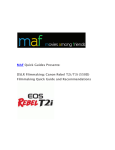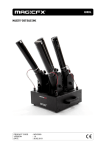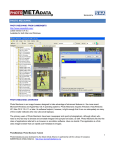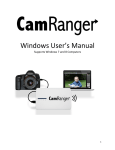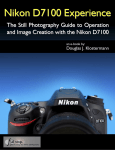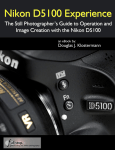Download camera essentials - Whitchurch Photographic Society
Transcript
camera essentials A camera out of the box is set up with default settings and usually with the novice in mind.. Probably most of us are guilty of putting the camera on Auto and firing away and being amazed at the images the camera captures. We also probably do this without reading the user manual..! There are some settings that would be of benefit being adjusted, especially if you want to get the best out of your camera and improve your creativity. The detail will be in the camera manual but the following should help navigate through some essential steps that will help improve your photography. Image Quality or file type. Usually set to JPEG files (Joint Photographic Experts Group) which is a basic standard across all image capturing devices and serves well. There will be differing sizes and qualities of JPEGs available within your camera system. The large JPEGs will take more card space as the files are bigger in comparison to Medium or Small JPEGs. Some old cameras can capture in TIFF format but generally this is a dying standard on consumer cameras. The other file type that needs to be considered is RAW. This is basically an unprocessed digital negative and creates a file (Nikon - NEF file, Canon - CR2 file) that contains all the data of a captured image. These images will need post processing on a computer to create printable and viewable images. The benefit is that all detail is recorded unlike a JPEG where the data has been compressed. Very large file sizes will mean that more storage space will be required on the camera card and computer. RAW is mainly used by the serious amateur and professional photographer. Colour Space. Altering the Colour Space is beneficial if you intend to print your images. sRGB is the one the camera will be set to by default and is good for viewing images on computer screens and sharing with others via the web and social media. Adobe 1998 - has a wider colour gamut and so more colour choice than sRGB. If you intend to print images then Adobe 1998 is a better colour space choice as a lot of printers can handle the larger array of colours. This can add benefit by producing better colour rich images. Not of use if the intention is to only use screens to view your images as only sRGB is displayed Take a look at the shooting modes. Five simple ones to get used to using are Landscape ! , Sports ! , Portrait ! , Night Portrait ! and Close Up ! . All of these will set the camera up and take some of the guessing out of using the camera in Auto. In the main these settings are utilising the 3 basic fundamentals of image capturing; Aperture, Shutter Speed and ISO. Although the latter is generally on auto. These 3 fundamentals will be discussed in other workshops. camera essentials Exposure Control - Highlight Warning and Exposure Compensation. You will have taken a photograph where parts of the image are too bright. This is most obvious in landscapes where the stormy or cloudy sky just looks far too bright and perhaps completely white. This happens where parts of the image are too bright for the camera to handle and in turn renders the colour as white. This can be hard to see on most camera displays especially when the overexposure (too bright) may be in a small part of the image. Perhaps the brides dress…! To help us see the issue most digital cameras can display a histogram and Highlight Warning. The latter is the simplest to use as it will flash on parts of the image that are over-exposed. This is a function that can be turned on or can be seen in the histogram view. Take time to find how to see the highlight warning. Once you understand that there is a warning you can then take steps to reduce or eliminate it with exposure compensation. This gives you the ability to either turn the exposure down (darken) or up depending what is desirable. An under exposed image is far better as it contains colour detail that can be “turned up” in a post processing application such as Photoshop Elements or Lightroom. Focussing Most cameras default to Auto Focussing and will generally mean that the camera will focus on the closest point. This can cause issues especially when the subject may be further back or to the side of the scene. Most cameras will give the ability to be more precise and focus in the correct place. On dSLR’s this is by using the touch screen or activating the Focus Point Selector. On bridge and compacts it is usually possible to make the section area smaller and move it around the screen. This is a really useful function as it allows the photographer to frame an image and not having to move once focussing has been achieved by half pressing the shutter button. The other method to be precise with which part is sharp is to use manual focussing. But this is down to the photographer having a good eye and more essential in closeup/macro type shots. Manual focussing is also useful in low light situations where contrast in the image is very poor. Focus Types Nearly all cameras are set to single Auto Focus. This means that once the shutter button is pressed halfway focus is set until the image is taken. This is fine for stationary subjects such as portraits and landscapes. If the image is moving then a continuous tracking method is far better. On Canon this is known as AI Servo and for Nikon AF-C.Using these modes means the camera will focus on the subject and track it as long as you have the shutter button half pressed. Therefore at the point of taking the subject should be in focus. This works well for a subject that is moving towards the camera. Some cameras also have an in between mode where the focussing starts as for a stationary subject and then changes to continuous if the subject starts to move. Using this function can build in some delay so better to think about the method prior to capturing..! camera essentials Metering is about how the camera assesses an image and sets the exposure settings. Nearly all cameras are set to an averaging mode where the whole image is viewed and an average exposure is set. On Canons this is called Evaluative and on Nikon Matrix Metering. This serves well for nearly all situations. It works by the cameras software having a store of many reference images. So when the shutter is half pressed the camera assess the image and refers to the reference library and sets the camera to a known similar image. There will be times though that the metering may need to be more precise for a given subject, perhaps a close up of a flower. In these cases the metering can be changed to assess a smaller part of the image and generally becomes more centre weighted. Spot Metering will assess the image at the focussing point so can be very exact. Shutter Modes Single Shot and Continuous shooting. The latter probably self explanatory. Continuous is useful for when children are playing or at the motor racing when getting a single image may not be the best. Multiple images will probably give you a series of images to pick the best from. There is also an option to delay the exposure by 2 or 10 secs. This is useful for when you may want to be in the image as well, especially the 10 sec option. 2 secs is useful for when you want to minimise the risk of camera shake when taking macro or low light images. The delay allows you to set the exposure but you will not be touching the camera at the point of when the image is taken and therefore no risk of camera shake. Of course this is when the camera is supported by a tripod or similar. Default settings It is always a good practice to put your camera into its default settings when you put it away. There is nothing more frustrating than when you take you camera out to take a quick picture and you have to start setting the camera up. Perhaps the last image you took was a 30 sec exposure on a very low ISO and small aperture. Not good when the image you now want to take is on the beach in glorious sunshine. Get into the habit of storing your camera with a set of default values: Aperture - f/11 ISO - 200 or 400 Metering - Evaluative/Matrix Focus point Central …. or of course …. Auto NOTES:



